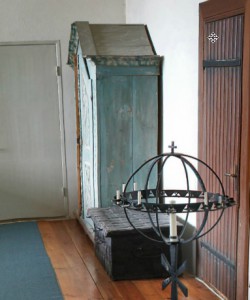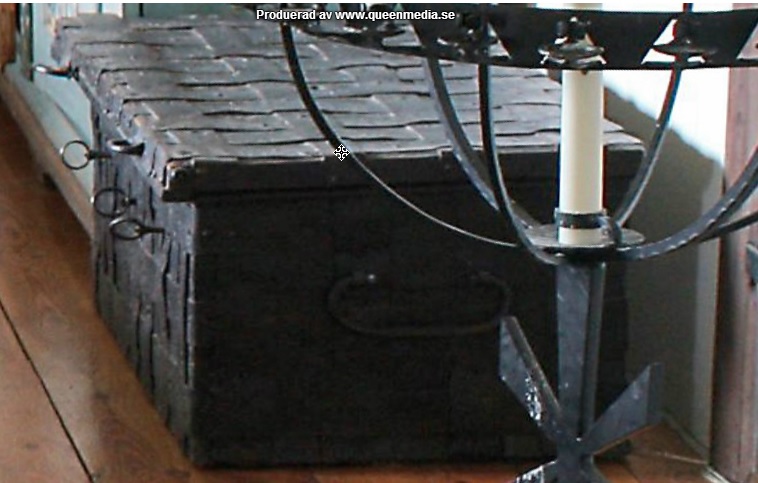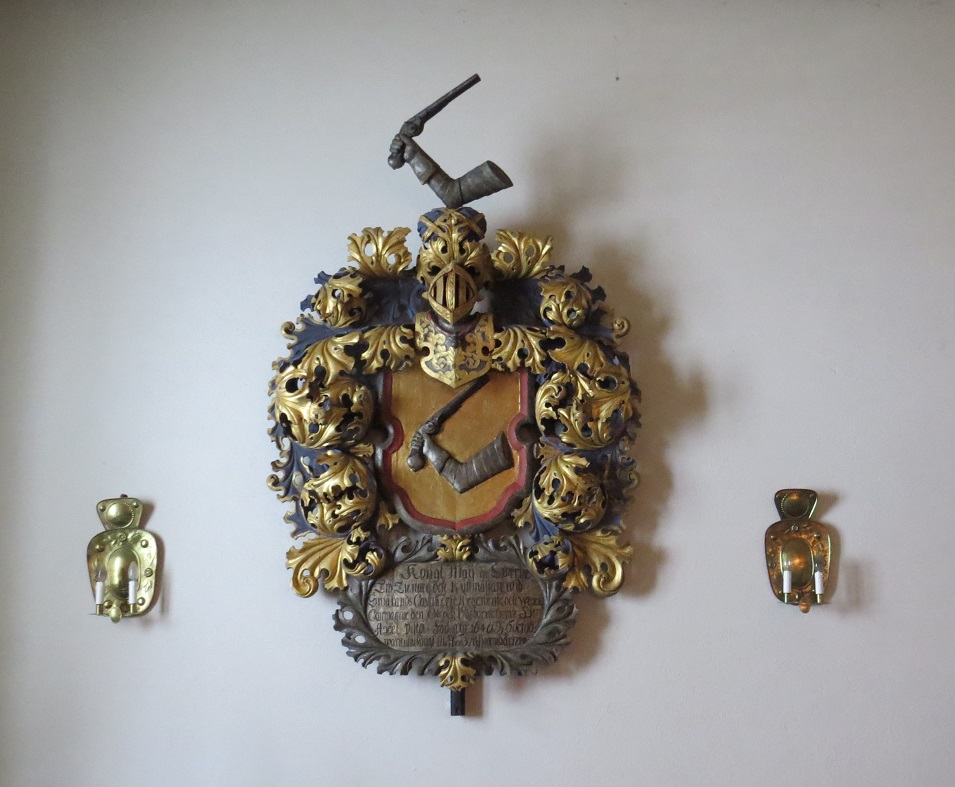I hope you enjoyed the panoramic video tour mentioned in the last post about Marbäck. Let’s take a closer look at a couple of the artifacts inside the church.

This is a view of the area to the left as you face the altar. Starting from the back we see an antique blue cabinet, a strange black box, and then a modern candle holder of some kind.
According the history booklet about the church, the cabinet is simply described as “a blue painted cabinet from around 1800.” Ho-hum.
The box, however, is some combination of the following:
a criminal stock, procured during the first half of the 1700s and a disgrace stool, on which one had to sit in the gangs as punishment for past crimes
And we’re displaying this in a church! Good grief!
Here’s a close-up of it:

So speaking of wildly inappropriate, how about the family crest that appears on the wall just a little more to the left of the blue cabinet area. In the video, it’s partially obscured by the light fixture, so here’s a photo that we took while we were there:
I guess what was most disturbing about this was the apparent suicidal nature of the image!
It turns out that this display is a memorial family crest for Axel Pistol, the son of Jakob Jacobsson. Jakob was knighted by the King of Sweden in 1636. He was a military officer, and must have performed some act of valor involving a gun (pistols were relatively new at the time), and so he took the name “Pistol”, which means the same in Swedish as in English. Jakob’s son Axel was also a military officer and was buried in the Marbäck church “where his weapon was set” (whatever that means).
In Sweden, all of the noble families are officially cataloged and numbered according to the date they were “introduced” at the Palace of Nobility. The Pistol family is part of the Untitled Nobility – that is, they’re not dukes or barons or counts. I think the English equivalent would be a mere “Sir” in front of your name. There is an entire website devoted to listing and descriptions of Swedish nobility. You can see the page for the Pistol family here. They are number 253 on a list that as of today goes all the way up to 2352.
Here is the family crest that is shown that is shown in the register and you can see that it corresponds very closely to the display on the church wall:

As for the position of the gun, I think they were using imagery that previously involved swords but were substituting their new-fangled pistol instead.
 To the right is some random family crest that has a sword. It makes sense; you can picture the knight raising his his sword in preparation to use it, making for a powerful and compelling image.
To the right is some random family crest that has a sword. It makes sense; you can picture the knight raising his his sword in preparation to use it, making for a powerful and compelling image.
It just doesn’t make sense when you substitute a gun for the sword, though. Did the designer of the family crest even know how a gun was used? Well anyway. I’m making too much of this but it was just such an odd and inappropriate image to be mounted on a church wall.
There is yet another memorial family crest in the church. This one is on the opposite side of the church and is obscured in the video by the free-standing organ. I did capture a photo of it while we were there.

This one is for the ‘Gyllenfalk’ family. The name translates as “Golden Falcon” so I guess it naturally lends itself to much better imagery.
This one is in memory of Jöran Gyllenfalk, whose family lands at number 346 on the list of Untitled Nobility.
Sir Golden Falcon was knighted in 1647 and was also a military officer. He too is buried at the Marbäck church.
I assume these home-town boys made good are buried in a crypt beneath the church, although the booklet is vague about these details, and Google had a hard time translating some of the specialized vocabulary associated with medieval churches.
Our next installment will take a look at the painted frescoes on the ceiling and arches of the church.


great photo’s!!!! thank you